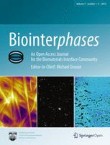Development of a Tuned Interfacial Force Field Parameter Set for the Simulation of Protein Adsorption to Silica Glass
Adsorption free energies for eight host–guest peptides (TGTG-X-GTGT, with X = N, D, G, K, F, T, W, and V) on two different silica surfaces [quartz (100) and silica glass] were calculated using umbrella samplin...

